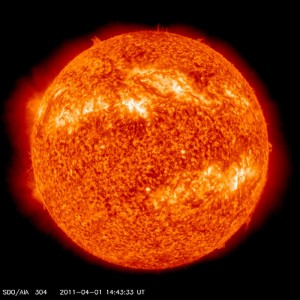There is a very nice report in the CNES ATV blog profiling the little-known work being done to protect ATV from space weather – solar radiation and especially energetic protons that can be emitted during solar events. Our quick and dirty translation is below – and when you’ve read today’s update read more on space weather and ESA’s Space Situational Awareness Programme here.- DGS
ATV-CC keeps a close watch on solar activity each day, as certain components of ATV Johannes Kepler are extremely sensitive to particles emitted during solar eruptions, or flares. Information on solar activity is taken into account by the flight procedures as a factor in delaying or postponing certain operations.
Who said that ATV was a simple mission?
European space expertise has proven itself capable – in the past with ATV Jules Verne and today with Kepler – of mastering complex mission requirements. ESA and CNES take into account, each day, a large number of parameters affecting flight operations – and monitoring solar activity is critical.
“ATV has shielding, but it can’t resist everything,” says Burkhard Jelineck, the CNES expert responsible for the ATV Training Academy and an experienced operations manager. “Some components on board, such as the optical docking sensors or the computers, are sensitive to solar particles. So, via ESA, we established a service contract with a subsidiary of CNES, Collecte Localisation Satellites (CLS), a satellite services and environmental data company that provides us with daily forecasts of solar activity.”
Watching closely
The reason for these forecasts? The ATV flight rules require that, when a solar event is predicted to deliver a dose of particles above a certain level, certain operations must be stopped or postponed until a later time.

The SDO Observatory, developed by NASA, enables us to understand how the solar magnetic field changes. Credits: NASA / SDO, 2011
To produce these forecasts, CLS conducts a daily check of solar activity.
“More precisely, this consists of assessing the risk of a solar eruption happening that could emit high-energy particles,” says Jean-Jacques Valette, a forecaster at CLS. “Even if the Earth’s magnetic field acts as a shield and traps the majority of the particles, the more energetic ones may pass through and affect equipment in orbit. The potential effects include changing the value of data stored in chip memories, stray electronic currents or short circuits.”
CLES experts pay particular attention to events that could generate protons, even though such events are very rare and only account for about 1% of all solar flares. There is currently no predictive model. “The method that we use is based on regular analysis of solar structures and their dynamics and checking for certain indicators,” explains Philippe Yaya, also a forecaster at CLS.
“We have established a number of indicators based on several solar cycles, during studies conducted in collaboration with L’Observatoire de Paris, the Ecole Polytechnique and CNES.”
A few extreme cases
When a major eruption occurs, the Sun may eject high-energy particles, mainly protons and nuclei of ionized atoms. These particles follow interplanetary magnetic field lines and collide with Earth’s magnetic field, which, like the atmosphere, acts as a shield to protect us.
The eruptions are not isolated cases – there are close to one hundred each month during the most intense phases of the solar cycle. That said, most are too weak to affect Earth. A solar cycle lasts about 11 years, with the last maximum reached in April 2000. And after having been just a little intense in the past few years, solar activity is starting to pick up.
“The eruptions are mostly seen during the solar maximum. We observe, however, that only a very small percentage are likely to eject energetic particles.”
For the record, the only risk encountered so far with ATV Johannes Kepler occurred before the vessel’s launch on board Ariane in February 2011. The event was important enough to put some indicators into ‘Red’, but not enough to declare a ‘NO-GO’ for launch.


 Automated Transfer Vehicle page
Automated Transfer Vehicle page ATV blog archive
ATV blog archive
Discussion: no comments